a new tabular data classification method that takes 1 second & yields SOTA performance (better than hyperparameter-optimized gradient boosting in 1h). Current limits: up to 1k data points, 100 features, 10 classes. 🧵1/6.


❤️ Check out Weights & Biases and say hi in their community forum here: https://wandb.me/paperforum.
📝 The paper “Temporally Stable Real-Time Joint Neural Denoising and Supersampling” is available here:
https://www.intel.com/content/www/us/en/developer/articles/t…pling.html.
📝 Our earlier paper with the spheres scene that took 3 weeks:
❤️ Watch these videos in early access on our Patreon page or join us here on YouTube:
- https://www.patreon.com/TwoMinutePapers.
- https://www.youtube.com/channel/UCbfYPyITQ-7l4upoX8nvctg/join.
🙏 We would like to thank our generous Patreon supporters who make Two Minute Papers possible:
Aleksandr Mashrabov, Alex Balfanz, Alex Haro, Andrew Melnychuk, Benji Rabhan, Bryan Learn, B Shang, Christian Ahlin, Eric Martel, Geronimo Moralez, Gordon Child, Jace O’Brien, Jack Lukic, John Le, Jonas, Jonathan, Kenneth Davis, Klaus Busse, Kyle Davis, Lorin Atzberger, Lukas Biewald, Luke Dominique Warner, Matthew Allen Fisher, Matthew Valle, Michael Albrecht, Michael Tedder, Nevin Spoljaric, Nikhil Velpanur, Owen Campbell-Moore, Owen Skarpness, Rajarshi Nigam, Ramsey Elbasheer, Steef, Taras Bobrovytsky, Ted Johnson, Thomas Krcmar, Timothy Sum Hon Mun, Torsten Reil, Tybie Fitzhugh, Ueli Gallizzi.
If you wish to appear here or pick up other perks, click here: https://www.patreon.com/TwoMinutePapers.
Thumbnail background design: Felícia Zsolnai-Fehér — http://felicia.hu.

The CRISPR system, which involves a Cas enzyme to cut DNA, is a powerful tool for gene editing. But the genetic scissors sometimes make changes at the wrong place, creating a major safety problem that could limit their therapeutic use.
Now, scientists at the University of Texas (UT) at Austin have refined the Cas9 protein used in the Nobel Prize-winning CRISPR-Cas9 tool. The new version, dubbed SuperFi-Cas9, was thousands of times less likely to perform off-target editing but just as efficient at on-target editing as the original version, the team said in a paper published in Nature.
“This really could be a game-changer in terms of a wider application of the CRISPR-Cas systems in gene editing,” Kenneth Johnson, Ph.D., the study’s co-senior author, said in a statement.

One day, we might be able to bring back to life every human ever lived, by the means of science and technology. And it will be a good day.
To the best of my knowledge, the idea was first described in detail by Fyodorov, a 19th century thinker.
Fyodorov argued that it is our moral duty to save our ancestors from the claws of death, to resurrect every human ever lived. And one day, we’ll have the technology.

Hydrogen gas could someday replace fossil fuels as a “clean” energy source, producing only water and energy. However, handling large quantities of gaseous hydrogen is cumbersome, and converting it to a liquid requires vessels that can withstand extremely high pressures. Now, researchers reporting in ACS Central Science have developed a method to store and release highly pure hydrogen with salts in the presence of amino acids.
The reversible storage of hydrogen in solid salts has emerged as one potential way to make the fuel easier to transport and handle, but the reactions to do this require precious metals as catalysts and may produce carbon dioxide as an unwanted byproduct. So, Henrik Junge, Matthias Beller and colleagues developed effective storage-release systems with both bicarbonate and carbonate salts, as well as manganese, which is a more widely available metal catalyst.
The researchers found that converting bicarbonate and hydrogen into formate, and vice versa, was most effective with potassium salts, a manganese-based catalyst and lysine—an amino acid that acted as an additional promoter and reacted with carbon dioxide to capture it—at reaction temperatures below 200 F. After five storage-release cycles, the reaction system produced hydrogen with a high yield (80%) and purity (99%).
Picture an entire city charged by batteries. This new battery design may unlock a new era of energy.

My name is Roman Stolyarov, and for my PhD work at the Media Lab I developed a terrain-adaptive control system for robotic leg prostheses. While modern prostheses allow people with leg amputations to get around, the way that they get around is often tiring, uncomfortable, and burdensome on their intact joints. In the worst case, irregular terrain geometries—from uneven sidewalks to rugged hiking trails—can be difficult or impossible to navigate with conventional prostheses, burdening the user’s mobility, independence, and sense of being able-bodied. My work was intended to help people with amputations feel as able-bodied and mobile as possible, by allowing them to walk seamlessly regardless of the ground terrain.

Atom containing an antiproton, the proton’s antimatter equivalent, in place of an electron has an unexpected response to laser light when immersed in superfluid helium, reports the ASACUSA collaboration at CERN
Established in 1954 and headquartered in Geneva, Switzerland, CERN is a European research organization that operates the Large Hadron Collider, the largest particle physics laboratory in the world. Its full name is the European Organization for Nuclear Research (French: Organisation européenne pour la recherche nucléaire) and the CERN acronym comes from the French Conseil Européen pour la Recherche Nucléaire.

GitHub Copilot, the text-to-code AI tool, has been—for the most part—revolutionary in determining how people code. Twitter has been erupting with people expressing how this new AI tool has benefitted them with organisation heads and developers alike hailing it for saving much of their time.
However, the latest discussion surrounding it suggests that things are murky.